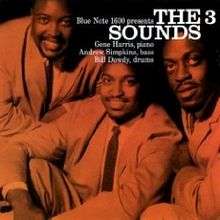Introducing the 3 Sounds
Introducing the 3 Sounds is the debut album by jazz group The Three Sounds featuring performances recorded in 1958 and released on the Blue Note label.[2] The CD reissue includes five bonus tracks and one alternate take originally issued in Japan as Introducing the 3 Sounds Volume 2. It was a continuation of the Blue Note 1500 series being numbered 1600. A few other albums were made intended for release as 1601, 1602 etc. but were not released at the time. Blue Note albums resumed with BLP (8)4001, (8)4002 etc. The 8 designating stereo.
| Introducing the 3 Sounds | ||||
|---|---|---|---|---|
 | ||||
| Studio album by | ||||
| Released | February 1959[1] | |||
| Recorded | September 16 & 18, 1958 Van Gelder Studio, Hackensack | |||
| Genre | Jazz | |||
| Length | 38:05 original LP 67:29 CD reissue | |||
| Label | Blue Note BLP 1600 | |||
| Producer | Alfred Lion | |||
| The Three Sounds chronology | ||||
| ||||
Reception
| Review scores | |
|---|---|
| Source | Rating |
| Allmusic | |
The Allmusic review by Stephen Thomas Erlewine awarded the album 5 stars stating "The Three Sounds never really deviated from the sound they established on Introducing, but that's one of the things that is so remarkable — they were fully formed on their very first album. Even if it was a peak, it wasn't the only peak in their career. They would often match the heights of this album, but this debut remains a shining jewel in their catalog, and the way to become acquainted with their sound".[3]
Track listing
All compositions by Gene Harris except as indicated
- "Tenderly" (Walter Gross, Jack Lawrence) - 4:36
- "Willow Weep for Me" (Ann Ronell) - 4:42
- "Both Sides" - 4:41
- "Blue Bells" - 4:25
- "It's Nice" - 4:39
- "Goin' Home" (Traditional) - 3:54
- "Woody 'n' You" (Gillespie) - 7:12
- "'O Sole Mio" (Giovanni Capurro, Eduardo di Capua) - 3:56
Bonus tracks on CD reissue: (Previously released as Introducing The 3 Sounds Vol. 2)
- "Bobby" - 4:26
- "Mo-Ge" - 4:25
- "It Might as Well Be Spring" (Hammerstein II, Rodgers) - 6:33
- "Soft Touch" - 3:43
- "Don't Get Around Much Anymore" (Ellington) - 4:39
- "Goin' Home" [Alternate take] - 5:38
Recorded on September 16 (tracks 1-3, 5, 9, 10 & 12), and September 18 (tracks 4, 6-8, 11, 13 & 14), 1958.
Personnel
- Gene Harris - piano, celeste tracks 4,6 and 14
- Andrew Simpkins - bass featured on track 11
- Bill Dowdy - drums
References
- Billboard Mar 2, 1959
- Blue Note discography accessed October 11, 2010
- Erlewine, S. T. Allmusic Review accessed October 11, 2010